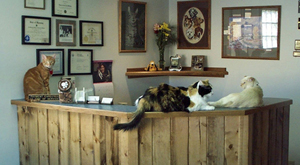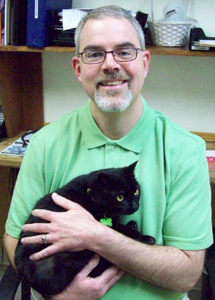feline receptionists Oursler

Three of Dr. Teri's clinic cats are seen acting as receptionists. Photo by Dr. Teri Ann Oursler
According to a survey amongst 1700 veterinarians who are members of the Veterinary Information Network, 60 percent of them have either a clinic cat or a clinic dog, with a whopping four percent who have both. I was glad to know I was not in the minority. In the 19 years I owned my practice, I was without a clinic cat for approximately three months, and those were when I first opened and word had not yet gotten out that there was a new sucker in town! At one point, we had 12 clinic cats. That's a lot, but we had a staff to clean up after them.
Drifter was one of my first clinic cats. He 'drifted’ into my life when I rented a house in the country, and unbeknownst to me it came with a pretty black and white cat. It did not take long to figure out why he had been left behind, as he sprayed. Behavior problems are a frequent reason a cat becomes a clinic cat. Interestingly, Drifter seldom exhibited that bad habit after moving to the clinic. What he did do, however, was become a great surrogate parent to a long line of orphaned kittens who came through my clinic. Wiley T (orange tabby on the left in the photo) was his first orphan, and Wiley never did leave as we fell in love with him (of course). Drifter would allow orphan kittens to nurse on him. Amazingly, they never seemed bothered by the lack of milk! We had quite a few bottle-fed babies and nothing is messier and harder to clean up than a bottle-fed kitten, or even worse, kittens just learning to eat a milk/canned food slurry from a bowl. Thankfully he was more than willing to groom each of these babies after their meals. Okay, it probably helped that they were covered in milk or slurry and tasted good! One afternoon, shortly after I brought in yet another motherless kitten, I heard the most mournful crying in the back room and went to see what was going on. It was Drifter, sitting in the middle of the empty exam room, just crying, as the kitten cavorted in the hall. I swear it was like a worn-out Mom going off to cry in her bedroom after a long day with a toddler. That was the last kitten Drifter raised, although he did continue to live at the clinic. I don’t know how many kittens Drifter raised before he finally called it quits, and I always wondered why he quit. He probably thought that there was an endless supply of orphans, he was not to blame for any of them, and decided retirement was best! I do know Drifter certainly gave back to the cat world and the humans who love them.
Joe Snyder clinic cat

Dr. Joe Snyder and Hannah. Photo by Laura Ferguson
Some cats come to the clinic with injuries and no money. Hannah came into a friend's clinic as a kitten with two broken legs and an owner who could not afford to fix her. One look into her beautiful green eyes and Dr. Joe was hooked. In two staged surgeries, her legs were repaired by my friend, Dr. Wendy, and her fellow associate Dr. Joe. By the time the kitten had been through rehab, she was a fixture at the clinic and everyone there loved her. Hannah spent 12 wonderful years in that clinic, even ended up with
her own Facebook page, in spite of the fact that she did not like to be picked for a photo op! She was so loved, she has not even been replaced since her death a year ago. However, I am absolutely certain that eventually another cat will find that clinic and make it home! But, remember, veterinarians cannot keep every broken cat or kitten that comes through the door.
Others become clinic cats because they choose the clinic as a place to live, and as you know, once a cat has chosen his place it can be very difficult to dissuade him otherwise. It was fall 2002 and we had noticed a buff-colored tabby cat hanging around the clinic. He tried several times to come in the front door, but Mags the Manx would get upset and chase him off whenever he tried. Finally, one morning he strolled in the back door with me and Mags appeared to not care that he came in as long as he did not come in the front door! I have no idea why there was a distinction, as my ability to read cat minds is severely limited to “my food dish is empty and the sunbeam needs to be uncovered." We advertised, looking for his owner, but to no avail. About a month later, I had a relief vet in and told him that since he had last been there, I had a new cat looking for a home. Dr. Dave looked at Buster, curled up in the cat tree, and stated the obvious: “I think he's done looking!” That was over 13 years ago and Buster is still at the clinic and giving clients his high fives and purring up a storm.
And who was Mags the Manx? He was a black and white manx cat who lived at my home and would get in the car every morning with my two dogs, two boys, and ride to the clinic. At 5 p.m., you would find him sitting inside the clinic's fenced yard, by the back gate, waiting to go home. When I opened the sliding door on my van, he would put himself in the car. I got more than one strange look as I drove around town with two black and white dogs with a black and white cat sitting up between them! He was my part-time clinic cat.
What do clinic cats do for a veterinary clinic, other than eat and cram themselves into and onto warm places? First, each clinic gives their cat a title. While I called my clinic cats my receptionists, my friend Michele called her cat Ginger, the office manager. Regardless of their human title, I am absolutely certain that all clinic cats believe their title to be God or Goddess and that the clinic could NOT function without them and their feline guidance.
First and foremost, my clinic cats were my goodwill ambassadors. They greeted clients at the front desk, making them feel welcome. They helped them write checks by biting on the pen as they wrote (maybe not so helpful as the cats thought). And more than one snuggled up to a client who was grieving the loss of their pet. I had quite a few clients who would come in just to visit my clinic cats, and my cats were more than willing to bask in their attention. I even had one client who would bring her out-of-town guests down to meet my clinic cats! They made my place a little-known tourist attraction in this small Wyoming town.
While Dr. Joe's Hannah was considered a part-time paperweight, my cats were more likely to stretch out on my desk, pushing papers onto the floor rather than securing them. While that is one way to excavate a messy desk, it is not very efficient and sure makes for a messy floor, to say nothing of the mess caused by the 'resorting' of my file piles!
Many veterinary clinics keep clinic cats and dogs as blood donors. Goosey Lucy (middle calico cat in the photo) was my feline blood donor. Just like human blood, you can only save the blood for so long after you collect it before you have to use it or toss it out. It is much more convenient, and easier to keep fresh, when you store the blood in the cat and only take it when you need it. There is also the added benefit that this type of container purrs and rubs up against you when you are lonely. And of course, the cats were there every day, when I or one of my staff had a hard day and needed a kitty hug! When you are feeling down, is there anything better than picking up and holding a purring fur ball?
And of course, they are there to raise orphan kittens. While not all of my cats were willing to be foster parents, Drifter was not alone in his quest to raise nice kittens who would go on to become great pets some place other than THEIR veterinary clinic.
There are a myriad of reasons as to why a veterinarian ends up with a clinic cat, and I have many more stories as each cat comes with his or her own story (Van Gogh is the cat on the right) but let me give you the short answer. It is because veterinarians have “sucker” painted on their foreheads, mostly in neon colors that can be seen from afar, and can be translated into every animal or human language on earth. Is there an icon for sucker? I am not sure, I am going to have to go look that up, or maybe I can just look in the mirror!
3 Comments
Tatiana
January 24, 2024
Such a sweet and beautifully written article! I find it fascinating that you can use them as blood donors as well! Thank you for sharing
Kelly Halley
April 30, 2016
Susanna Hofher
April 19, 2016